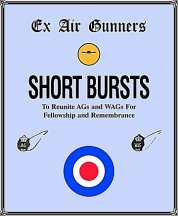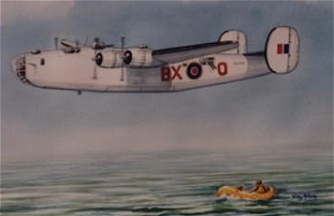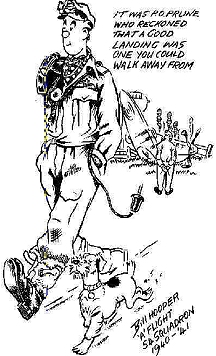BRANCH REPORTS
Northern Saskatchewan Branch
On June 18th, 21 members of the Ex A/G's Ass'n gathered
at the RCAF Ass'n Lynx Wing and enjoyed a nice lunch served by the workers
at the Lynx Wing. Our finances continue in good shape under the careful
attention given by Treasurer Doug Warren.
We will be meeting on the 3rd Monday in July at the
usual Lynx Wing spot at noon hour; visitors are welcome.
This is another experience
of C.A. "Smokey" Robson
On the 12th of October 1941, our crew under the leadership
of Sgt. Bill Stewart, attacked Nuremberg. It was an 8 hour and 40
minute mission.
Upon our return, after crossing the French coast, to
come up into East Anglia, we were diverted to RAF Station Abingdon.
The initial reaction of our captain, Sgt. Stewart,
was to ask the wireless operator air gunner for a bearing on Abingdon;
all the aircraft that were diverted to Abingdon were similarly trying to
get bearings on Abingdon.
Our fuel was getting low and our captain, Sgt. Stewart,
felt that unless we could find a spot that was open to land, that we may
have to put the aircraft down in a field.
Talking about putting the aircraft down in the field,
we came across what appeared to be a stream flowing through a field and
our captain, Sgt. Stewart, made a decision that he was going to land in
that field beside the stream.
As we got lower and closer to the so called field,
we discovered that the stream was actually camouflage painted on the runway
and we later found out we had landed at Royal Airforce Station Northholt
which is within the limits of the city of London.
When we got out of our aircraft all we could hear was
a foreign language and the captain asked the front gunner if he was accurate
in his pinpoint that we had received when we came out of the French Coast,
and of course, he said "he was".
We thought we might still be in Germany or God knows
where and then we discovered that at Northholt in the city of London, there
were three Polish fighter squadrons. This is where we had landed,
at the Northholt Airport with three Polish fighter squadrons at that airport
and this was the foreign language we heard.
We all were escorted to the lounge in the Sergeants
Mess and had a bit of sleep and the got up the next morning and took off
from Northholt and proceeded to return to Mildenhall
Manitoba
Branch
Recently we gave donations to the following:
1. Air Cadet League of Canada (Manitoba) Inc.
The money will be used to assist the League attain their goal of providing
an opportunity for each Air Cadet to have a Familiarization flight in a
Glider.
2. Commonwealth Air Training Plan Museum Inc., Brandon,
MB in appreciation and to help offset costs in publishing SHORT BURSTS
on the Internet and assist in keeping the Museum going.
At our 1994 Reunion I met Len Isaacson of Lethbridge,
AB who, at the age of 84, dances at the R.C. Legion every Friday night.
He sent me a letter in June 2001 which mentions his experience with German
Night Fighter Planes (NACHTJAGD) equipped with CHRAGE MUSIK. This
article will be included in the first available issue of our Monthly Newsletter
- SHORT BURSTS .
Earl Hiscox reports that he had the Canadian and Air
Force flags proudly flying from his Short Wave Antenna on Canada Day.
Good Show, Earl - we must keep the old flag flying!
We continue to hold a monthly meeting every second
Thursday of the month at noon for those able and willing to attend.
No formality - just an opportunity for lunch, fun and comradship,
Attendance varies from 4 to 15 including spouse/partners.
On July 12th we will be visiting Les & Leta Sundell
at their country abode in Sanford, MB for a Barbeque (or a Barley as the
Aussies say).
During the Reunion 2000 in Edmonton, I was talking
to two of our members from British Columbia. It turned out they were
members of a Lion's Club in that Province (a great international service
organization to which I also belong in Winnipeg). A practice many
Lion's take part in is the trading of Club Pins. They each gave me
one of theirs. I did not have any with me but promised to send them
one when I returned home. I have lost/missplaced their names and
address. HELP!!! I can't remember their names - I think they
were from Vancouver Island. I'd like to keep my promise. Any
help will be appreciated. Thanks.
The Manitoba AG/WAG's send GREETINGS to their comrades
everywhere
Howard Elliott
Southern Ontario Branch
Apropos your article in April issue of Short Bursts
re: gunners who flew in Stirlings.
One of our members, namely Charlie Randall, did all
his ops in Stirlings I III and IVs as a tail gunner in 190
Squadron, 38 Group. These aircraft had the mid-upper turret removed
and were used to drop supplies to the underground in Norway, France and
Holland.
Paratroopers were also dropped at various times, and
gliders, mostly Horsas, were towed to drop areas. On September 18/44 gliders
were towed to Arnhem from Fairford. This crew dropped paniers
containing knock down motor cycles, machine guns and ammunition on September
20th.
They were slated to go again on September 22 but the
operation was scrubbed due to lack of serviceable aircraft.
On the previous day the squadron dispatched 10 aircraft
and only three returned. Losses were also sustained on previous days.
In March 1945 gliders were also dropped during the Crossing of the Rhine
from their new location at Great Dunmow, Essex.
At wars end the squadron flew the 1st Airborne Division
to Oslo to accept the German surrender of Norway. Charlie vividly remembers
their first landing between rows and rows of parked Junkers 88's and Focke-Wulf
190s. They also flew plane loads of petrol to Brussels and returned with
ex POWs.
(Submitted from the Toronto Chapter as relayed by
Charles (Charlie) Randall, AG 190 Squadron 38 Group)
Northern Alberta Branch
Evening John. I hope your "wound" is much better
and that you will be back to normal soon. I have a bit of news for
Shortbursts. At our July meeting it was decided that we should send a donation
of $200 to the Edmonton Police Helicopter Fund. The EPS have been
trying to get a helicopter for some time but City Council has, as usual,
been diddling about so someone started a fund to finance the deal. They
have raised almost the 1 million dollars that they require.
At the same meeting it was decided that we would continue
to meet at the Jasper Place Legion and we will change our meeting day from
the third Thursday to the first Thursday of each month.
Ted Hackett
Doug Penny
I would like to thank Charlie Yule and John Moyles
for their continued interest in the Ex-Air Gunners Association. During
my time as the National President, 1990- to 2000, it was an honour and
pleasure to work with these two men, plus all Directors from across Canada.
It gave me a lot of satisfaction to be able to put something back
to the members former and present. It was the wish of the members at our
final reunion in Edmonton 2000, that we keep information available to them.
With the help of John and Charlie, plus input from our members, and the
expertise of our volunteer Webmasters, Bill and Sue-On Hillman from the
Brandon Museum, the wishes of our members have been fulfilled. Someone
once told me the Ex-AG Association was a class act.We hope this was true.
We have had, over the years, a great deal of input from members all over
the world. Thank you again!
Sadly, some of our members have passed on since Edmonton
2000. One person I remember from Squadron days was Andy Lagimodiere from
Winnipeg who recently died after as long illness. We were on 432
Squadron, North Yorks, in early 1944. I met Andy when my skipper, “Pete”
Pettit, and crew came from 420 Squadron to Eastmoor. Pete was a Canadian
starting his second tour. When Andy and I would meet at AG and Wartrime
Air Crew reunions, we would hoist a pint or three and talk about old times.We
would talk about the trip to Nurnberg. A cold billiant moonlit night with
lots of action in the skies. The reported losses from Bomber Command ranged
from 96 to 104 Heavies. It was my longest Op, about 8 hrs. and 25 min.
The other awe enspiring trip was on D Day morning, before the boys landed
at Normandy. We could see the shipping in the Channel, large destroyers
firing rockets and other heavy guns dropping shells on the French coast.
The sky was full of aircraft, mostly ours, and the sun was just coming
up. Of course, this was June 6, 1944.
At the end of June Andy contracted mumps and was grounded..
His pilot, Walt Fernyhough, picked up the Gunnery Leader, A.J. Williams,
RAF, as his spare gunner. They went missing June 29th. and Andy was a spare
gunner from then on.
We were on leave one time in early June ’44 and Andy
met another Winnipeg lad, Andy Mynarski VC. Andy Mynarski was on 419 Squadron
and went missing on a raid on June 13, 1944.
Memories we will all cherish.
Good health to all.
Doug Penny, Calgary.
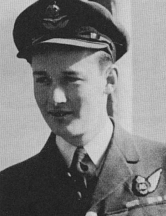
Doug Penny
National President ~ 1990-2000
This was Doug when he could still hoist one or three!
Ray Stoy
I'm still enjoying the internet versions. In
the current June issue my e-mail address was not with my name and address.
To date I have not had a single inquirey about my prints, where as
when information was printed in the earlier printed Short Bursts I would
have 5 or 6 each time there was copy in print. I can assume that
it's due to the lack of information, such as a list of aircraft available,
size matted print 20" x 14.5" for $30us. plus $5.50 us shipping.
I may be wrong but I don't think so. I do appreciate your printing
the photos etc. I can send some copy if that would help.
I have been thinking about the Halifax Mk. 4 at Marston
Moor. I was stationed there flying Halifax Mk. 3 and the more that
I think about the stories about the Mk. 4 the more I find them very, very
hard to believe. The station wasn't so large that you could hide a Squadron
of four motor aircraft. Also in the mess hall and around the bar
I'm sure I would have noticed a strange brevy such as stoker AG, it was
a very intersting story to read and if it was factual the amount of Oxygen
needed to keep the
coal fire burning would be very large indeed.
In any case in trying to wrack my brain for details of Marston Moor and
what we did while we were stationed there, I was brought to remember that
shortly after arriving at Marston Moor from Acaster Malvis our skipper
was promoted to WO1 and need an officers uniform. All 7 of
the crew were given 10 days leave so he could go to London to have the
uniform made. The 6 Canadians all left for London to stay at the
Canadian Legion Hotel at Russel Square. Our enginer was English and
in the RAF so he just went home, near London. The cost for the hotel was
2 and 6 for bed & breakfast. We spent much of our time at Bars
around town and at tea dances. After 10 days we had spent just about
all of our money we took the train back to Marston Moor. When we
arrived at the gate the guard said the station had been closed by the MO
due to malnutrition and lack of coal. We were given a train pass
back to London where we went to the Canadian Legion Hotel in Russel Square.
Next day we went to the RCAF in London to see if we could be paid, they
said your attached to the RAF and they are the ones to pay you. We
then went to the RAF headquarters in London and they said " you are Canadians,
you have to get paid by the paymaster at your station" We went back
to the Canadian Legion hotel and they said why don't you go to see Watney
Brewery at Victoria Station, they are always looking for help since everyone
is in the service or have better jobs. We went to the Brewery, a
2pence ride on the tube, we 6 Canadians we hired on the spot for
14 and 6 a day, with a hot lunch, some kind of gruel and bread, better
than we were gettin back at Marston Moor. We had all the beer we
could drink, without our boss seeing, and we worked in our uniforms, rolling
empty beer kegs around from one building where they were washed, across
the court yard with horse manure every where, the barrels had 2 open holes
so I suspect that the beer would have some horse flavor after they were
filled. We had a good time as 14 and six was just for supper and
some more beer at night, Thats about all I can remember of Marston
Moor and after that we were stationed at Wolfox Lodge, near Oakham, Rutland
to fly Lancasters.
Cheers Ray
Stoy
{Ed. The Liberator at the top
of this page is one of Ray’s paintings.
If you are interested in aquiring one of Ray’s
prints contact him at:
7728 U.S. Open Loop, Bradenton, FL 34202 U.S.A.
Ph: (941)907-6077 Email rpstoy@juno.com
)
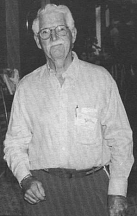
Roy Stoy ~ Florida
At the Edmonton 2000 Reunion
Len Isaacson
We had dropped our bombs on a synthetic-oil plant in
Gelsenkirchen, Germany the night of June 12/13, 1944 and were headed for
base. In the tail gun turret I was searching in the dark for any
enemy fighters who might be following us out of the target area.
Suddenly I heard cannons barking loudly and saw lights flashing directly
below. What the hell was that? I didn’t see the fighter – just
the flashing. We took evasive action and that was it.
At base the pilot told me he saw tracers streaking
up in front of him at a steep angle. I wondered how a night fighter
could be so very close under our Lanc and yet be able to fire upwards at
about 70 degree angle. At that time we didn’t know about ‘Schrage
Musik’ – two upward firing cannons fitted in the rear cockpit of a Messerschmitt
110. Lucky for us the German pilot sneaked a bit too far forward
and missed. According to ‘Bomber Command War Diaries’ the first time
the Luftwaffe used ‘Schrage Musik’ was during the bombing of Peenemunde,
August 17/18, 1943 and are believed to have shot down six bombers.
I completed my tour of 31 Operatons on August 30, 1944 still wondering
– ‘What the hell was that?’
In the Airmail section of the Winter 2000 issue of
‘Airforce’ I see that J. McLean and a group of 36 Air-gunners, arrived
in England in June 1944 and were sent directly into training and on to
a squadron the first week in August 1944. McLean states: “This quick
trip to squadron was necessitated so we could man the newly installed Ventral
Gun Position on the Hallies to combat Schrage Musik…”. Since Bomber
Command knew about the weapon in June, and perhaps earlier, I wonder why
all squadron were not alerted and when were they alerted. I would
like to hear from anyone who had any experience with those cannons, or
any information you can give me.
Leonard J. Isaacson, 228 Corvette
Crescent, Lethbridge, AB T1J 3X8
May I add, as a Postscript, that even with the noises
of the Lancasters, motors and wind, and with my helmet on and earphones
over my ears, I very clearly heard the very loud barking of the cannons.
There is no doubt in my mind that it was S.M.
So – I decided to dig deep into the questions about
S.M. and pass the info on to my ex-Bomber Command friends who have not
heard, even yet, about S.M. and to some who doubt that it was ever in action.
I can understand this, since it seemed to be such a secret. In all
my searching I have found no one who had heard about the S.M. while on
squadron. I have a lot of info about S.M. that my brother found on
the Internet. However, what I have revealed should be evidence enough.
Why were not all squadrons alerted? Perhaps the
best answer I’ve had is from an ex-Navigator from 429 Squadron who completed
32 operations in a Halifax III. In a letter to me he said, “I’m sure
that no historian will ever unearth any document which states the reason
for not telling us, nor even one which states that we should not be told.
The secret reason for this lack of information will probably die with the
man who made the decision.”
If you are on the Internet just ENTER ‘Schrage Musik’
and see what it comes up with.
Some information from the Internet:
‘SCHRAGE MUSIK’ – a German nickname given to the Nachtjagd
‘Night Fighter Planes’ equipped with two MG ff’s or MG 151/20s 20mm cannons
mounted in the cabin or fuselage at a 70-80 angle which were aimed by a
second Revi C 12/D or 16B gun sight mounted on the canopy roof. ‘Schrage
Musik’ proved to be lethal and took a fearsome toll of heavy bombers in
the night battles.
The following excerpts are from the book ‘The Other
Battle – Luftwaffe Night Aces Versus Bomber Command’ published in 1996
by Motorbooks International Publishers & Wholesalers, 729 Prospect
Ave., PO Box 1, Oscela, WI 54020 USA:
AUTHOR: Peter Hinchliffe OBE, flew with Bomber Command
as a Navigator in 1944 and 1945, during which time he was shot down over
Belgium in the course of an operational sortie. After the War he
served as a Fighter Controller, so therefore has professional insight into
the problems, practices and techniques of air defense and radar controlled
air interception, as well as a detailed understanding of aerial navigation
and electronic technology.
On leaving the RAF in 1966 he joined the Foreign and
Commonwealth Office in London, travelling frequently in Germany.
He numbers among his German acquaintances many wartime nightfighter crewmen,
some of whom held positions of considerable eminence in the Luftwaffe,
and from them he gained much firsthand material for this book.
Foreword by Marshall of the Royal Air Force Sir Michael
Betham GCB CBE DFC AFC, President of the Bomber Command Association, formerly
Chief of Air Staff.
Foreword by Oberst a.D. Wolfgang Falck of St. Ulrich
a.P. Austria:
I consider this a great honor to have been asked to
write a foreword to the book that Peter Hinchliffe has written. It
is a characteristic of this work, in which the author is at pains to give
an objective account of the murderous battle between the RAF and the German
night fighters sine ira et studio, that he has succeeded in exemplary fashion.
It is surely no easy task to write objectively about a matter in which
the youthful elite of two nations were killing each other.
Let us hope that with the publication of this book
Peter Hinchliffe will have played a part in ensuring that the generations
that follow us will learn from what happened in the past and will look
to the future with goodwill and in the knowledge that international problems,
no matter what they might be, can no longer be solved by means of force.
It is up to us to make our individual contribution to the creation of a
peaceful future.
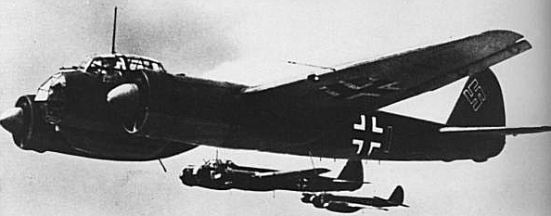
Junkers JU 88A-4 was the most widely-used bomber
version of this famous a/c.
These are shown during a raid on Britain in 1940
Excerpts from the book:
P127: Equally deadly for attacking bombers in their
unprotected belly, were two 30mm MK 108 upward-Pointing cannon (600 rounds
per minute each) in a so-called Schrage Musik installation in the fuselage
roof, of which we will speak later at great length.
P136: On the German side there was emerging a new weapon
which, carried principally by the Ju 88s, would prove to be frighteningly
efficient against the RAF heavy bombers. As is very often the case,
it is unclear who first thought of mounting machine guns or cannon on the
top surface of a night fighter so that all the pilot had to do was to position
his machine under the bomber and then open fire.
P137: The installation attracted the attention of an
armaments NCO, Oberfeldwebel Mahler, who built two 22mm Oerlikon MG FF
machine-guns into the cabin roof of a Bf110. Using this do-it-yourself
weaponry, Schoenert achieved the first acknowleged Schrage Musik kill in
about May 1943. (emphasis added)
P138: The Schrage Musik cannon fired a lethal mixture
of armour-piercing, explosive and incendiary ammunition, and a split-second
burst, a single pressure of the thumb on the fire button, was usually sufficient
to set the wing ablaze and damage the Stirling, Lancaster, or Halifax beyond
hope of recovery.
P139: Most British crews did not know they were in
danger from a fighter beneath them until they heard a short series of violent
explosions and realized almost simultaneously that their aircraft was on
fire. The fortunate ones had time to bale out; the unfortunate ones
had only a few moments to live. Schrage Musik came into its own with
devastating effect during the second half of 1943 and the first half of
1944. (emphasis added)
Wilhelm Seuss of IV/NJG5 is quoted on P252: It
was Seuss’s second kill, his first with Schrage Musik. It was, he
said, so simple. He was flying a borrowed aircraft – his own machine
had not yet been fitted with the upward-firing cannon – and all he had
to do was to slide beneath his victim and aim between the two port engines.
Another quote from Seuss:
P254: My Schrage Musik was out of ammunition, and my
funker had to change the drum. It took three or four minutes and I stayed
under the Viermot (a four engine aircraft), and he didn’t see me.
Then, just as I fired, he dived to one side and flew through my burst of
cannon fire, and he began to burn immediately.
P253: By this period, too, more fighters were carrying
SN-2 interception radar, still impervious to Window, and more were armed
with the deadly Schrage Musik, the existence of which was still unsuspected
by the crews in the heavy bombers – even it seems, by the intelligence
officers of the Bomber Command. (emphasis added)
P263: That night No. 77 Squadron was fortunate, not
losing a single machine. Crews from the squadron did, however, witness
the loss of aircraft from other squadrons, albeit unwittingly. The
Operations Record Book for the squadron contains this extract: “Amiens
to French coast – only light flak. Up to twenty searchlights operating
in target area. About ten new ‘scarecrow’ flares reported on route
home from France.’ In the later months there had been an increasing
number of report of these ‘scarecrows’ from bomber crews, a new phenomenon
– violent flaming explosions in the vicinity of the bomber stream.
These were, it was firmly believed, special shells fired by the Germans
that were intended to simulate aircraft exploding and so to deter the bomber
crews.
The irony is that the Germans had no such devices;
what the RAF aircrew were seeing were actual bombers exploding, in all
probability victims of night-fighter attacks from below with the so far
unsuspected Schrage Musik. (emphasis added)
The concluding paragraph of the book:
P335: The tumult and the shouting had died, the captains
and the kings departed. History decreed that some departed to glory,
acclaim and high office; some to death, some to rejection and comparative
oblivion. And the flyers from both Bomber Command and the Nachtjagd
who fought so bitterly against each other, those who survived, departed
to begin a new life, each in his own separate way. As they grow older,
perhaps wiser, possibly more compassionate, they will all ask the same
question. Why? And there is no answer.
From your Editor
First, I want to apologize for being late with the
July Page. While engaging in my hobby, wood carving, the knife slipped
and I ended up with 7 stitches in my right hand between thumb and forefinger.
This makes typing difficult. (Charlie Yule informed me that monkeys
do not use their thumbs!)
Bud and June Crookes, the Editors of the 422 Squadron
Web Page have published a book on the squadron on their site.
www.georgian.net/422sqdrn/hbk0covr.htm
They have done a bang-up job, check it out.
A little trivia. Did you know that Bill Hooper,
the creator of P/O Prune, was an Air Gunner!
Some administrative type must have had his finger
in as Bill was posted to 54 Squadron, an RAF Spitfire outfit. That is why
we see Prune walking away from, and falling out of, Spitfires. Hanging
around the flights sketching the silk scarf boys, Bill’s cartooning talents
were recognized, and he was posted, along with Prune, to HQ in London and
attached to the TEE EMM Staff. Later in the war said Admin Type got the
finger out and Bill received a posting to the Far East – Burma! However,
by that time Bill was indispensable. Oh yes, the Luftwaffe awarded
Prune the Iron Cross for destroying so many allied aircraft!
Hopefully, I will have the stitches out and raring
to go, come August. Until then, drop me some copy for the Page.
Keep well, Cheers,
John Moyles
